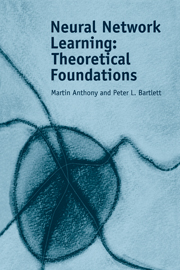Book contents
1 - Introduction
Published online by Cambridge University Press: 26 February 2010
Summary
Supervised Learning
This book is about the use of artificial neural networks for supervised learning problems. Many such problems occur in practical applications of artificial neural networks. For example, a neural network might be used as a component of a face recognition system for a security application. After seeing a number of images of legitimate users' faces, the network needs to determine accurately whether a new image corresponds to the face of a legitimate user or an imposter. In other applications, such as the prediction of future price of shares on the stock exchange, we may require a neural network to model the relationship between a pattern and a real-valued quantity.
In general, in a supervised learning problem, the learning system must predict the labels of patterns, where the label might be a class label or a real number. During training, it receives some partial information about the true relationship between patterns and their labels in the form of a number of correctly labelled patterns. For example, in the face recognition application, the learning system receives a number of images, each labelled as either a legitimate user or an imposter. Learning to accurately label patterns from training data in this way has two major advantages over designing a hard-wired system to solve the same problem: it can save an enormous amount of design effort, and it can be used for problems that cannot easily be specified precisely in advance, perhaps because the environment is changing.
- Type
- Chapter
- Information
- Neural Network LearningTheoretical Foundations, pp. 1 - 10Publisher: Cambridge University PressPrint publication year: 1999

